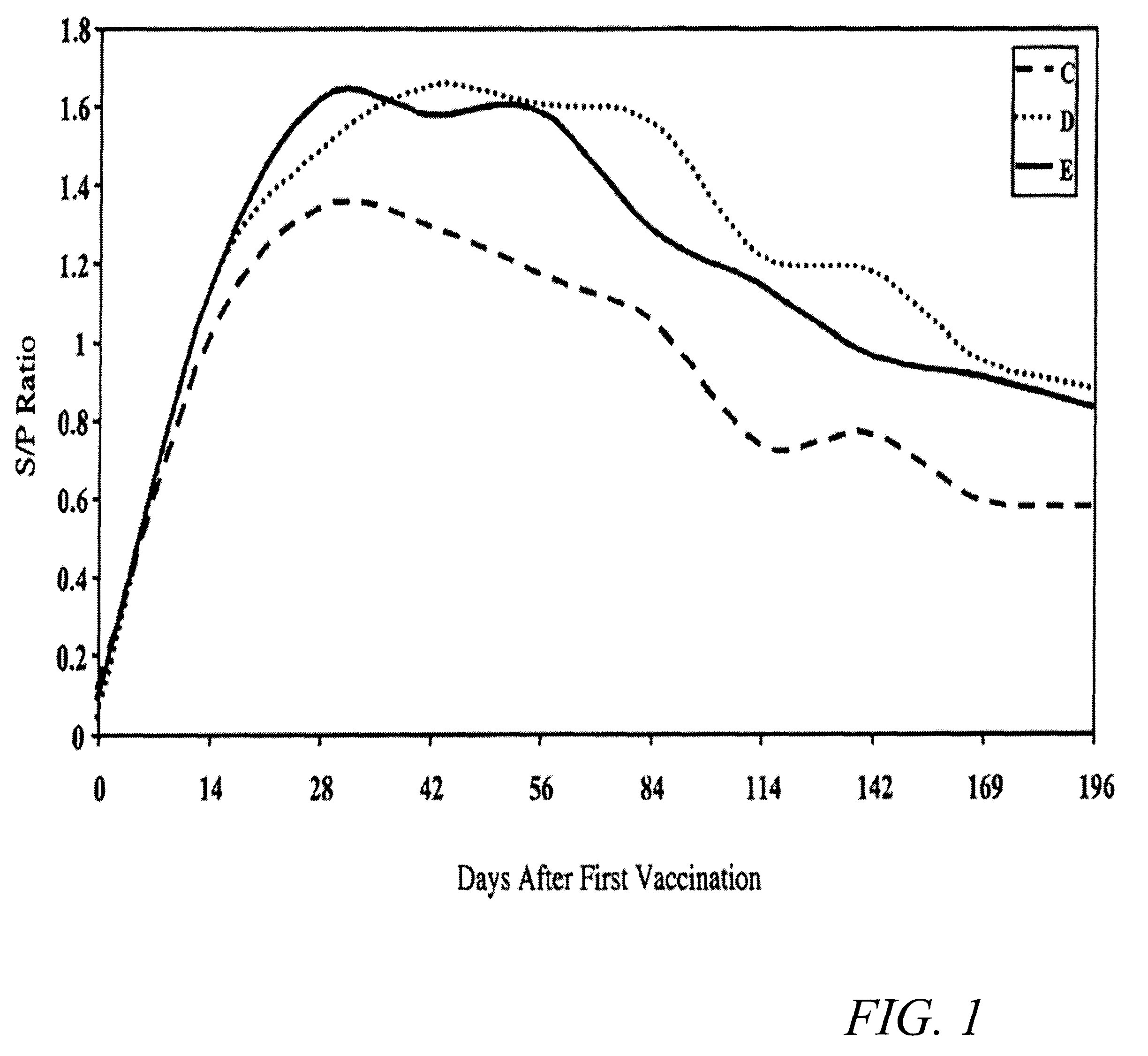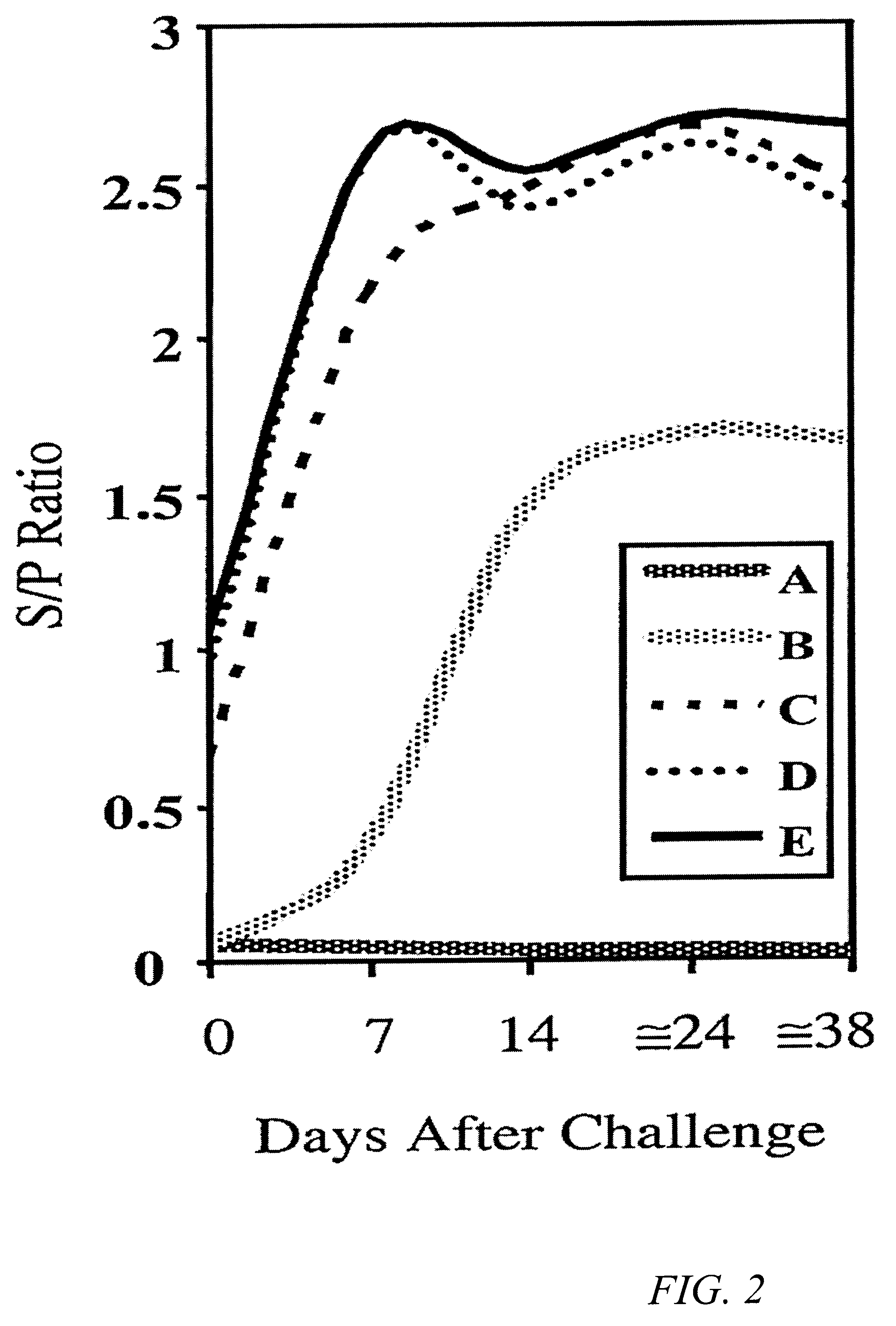Porcine reproductive and respiratory syndrome vaccine, based on isolate JA-142
a technology vaccine, which is applied in the field of reproductive and respiratory syndrome vaccine, can solve the problems of increased number of stillborn, mummified and weak-born pigs, and reduced farrowing rate, so as to shorten the time to attenuation and ensure the effect of logarithmic replication
- Summary
- Abstract
- Description
- Claims
- Application Information
AI Technical Summary
Benefits of technology
Problems solved by technology
Method used
Image
Examples
example 2
Materials and Methods
This example determined if passage 200 of PRRS Virus, JA-142, would revert in virulence when passed in the host animal six times. This study consisted of six groups. Five pigs from group 1 (principle group) were inoculated intra-nasally with PRRS MSV, JA-142 passage 200, while three pigs from group 1A, (control group) were inoculated intra-nasally with sterile diluent. The animals were provided commercial feed and water ad libitum throughout the study. Pigs of both treatment groups were monitored daily for clinical signs (appearance, respiratory, feces, etc.). After six days, the animals were weighed, bled and sacrificed. After scoring the lungs for lesions, lung lavages were collected from each animal. The lung lavages were frozen and thawed one time, and a pool was prepared using 2.0 ml of serum and 2.0 ml of lung lavage from each animal within a group to prepare Backpassage 1 and 1A, respectively. This pool was used to challenge (intra-nasally) the animals in...
example 3
Materials and Methods
This example demonstrated that the level of attenuation of safety of MSV, JA-142, passage 200 did not change significantly during six backpassages in the host animal. Evaluation of level of attenuation or safety was performed using the pregnant sow model and monitoring the effect on reproductive performance. This model is the most sensitive test system and does not rely upon subjective factors for virulence testing. This example consisted of four groups (A, B, C & D) having seven sows per group. Group A was inoculated intra-nasally with PRRS MSV, JA-142 passage 200. Group B was inoculated intra-nasally with JA-142, passage 200, Backpassage 6. Group C was inoculated intra-nasally with sterile diluent, to act as normal controls. Group D was inoculated intra-nasally with PRRSV JA-142, passage 4. The test articles (challenge with JA-142, passage 4) were given at about 93 days gestation. Body temperatures of the sows were monitored for the first seven days following ...
example 4
Materials and Methods
This example evaluated the safety and level of attenuation of administering a 10.times. concentration of MSV, JA-142, passage 201. The study was performed on the pregnant sow model and monitored the effect of this dosage on reproductive performance. The study consisted of three groups, A, C, and D. Group A was inoculated intra-nasally with PRRS MSV, JA-142, passage 200. Group C was inoculated intra-nasally with sterile diluent, to act as a normal control group. Group D was inoculated intra-nasally with 10.times. JA-142, passage 201. All inoculations were given at about 93 days gestation. Body temperatures of the sows were monitored for the first seven days following inoculation (vaccination). Blood samples were collected from the sows once a week and at time of farrowing. Prior to and following inoculation, total white blood cell counts were determined as in Example 2. The health status of each animal was monitored daily for the duration of the study up to and f...
PUM
 Login to View More
Login to View More Abstract
Description
Claims
Application Information
 Login to View More
Login to View More - R&D
- Intellectual Property
- Life Sciences
- Materials
- Tech Scout
- Unparalleled Data Quality
- Higher Quality Content
- 60% Fewer Hallucinations
Browse by: Latest US Patents, China's latest patents, Technical Efficacy Thesaurus, Application Domain, Technology Topic, Popular Technical Reports.
© 2025 PatSnap. All rights reserved.Legal|Privacy policy|Modern Slavery Act Transparency Statement|Sitemap|About US| Contact US: help@patsnap.com


